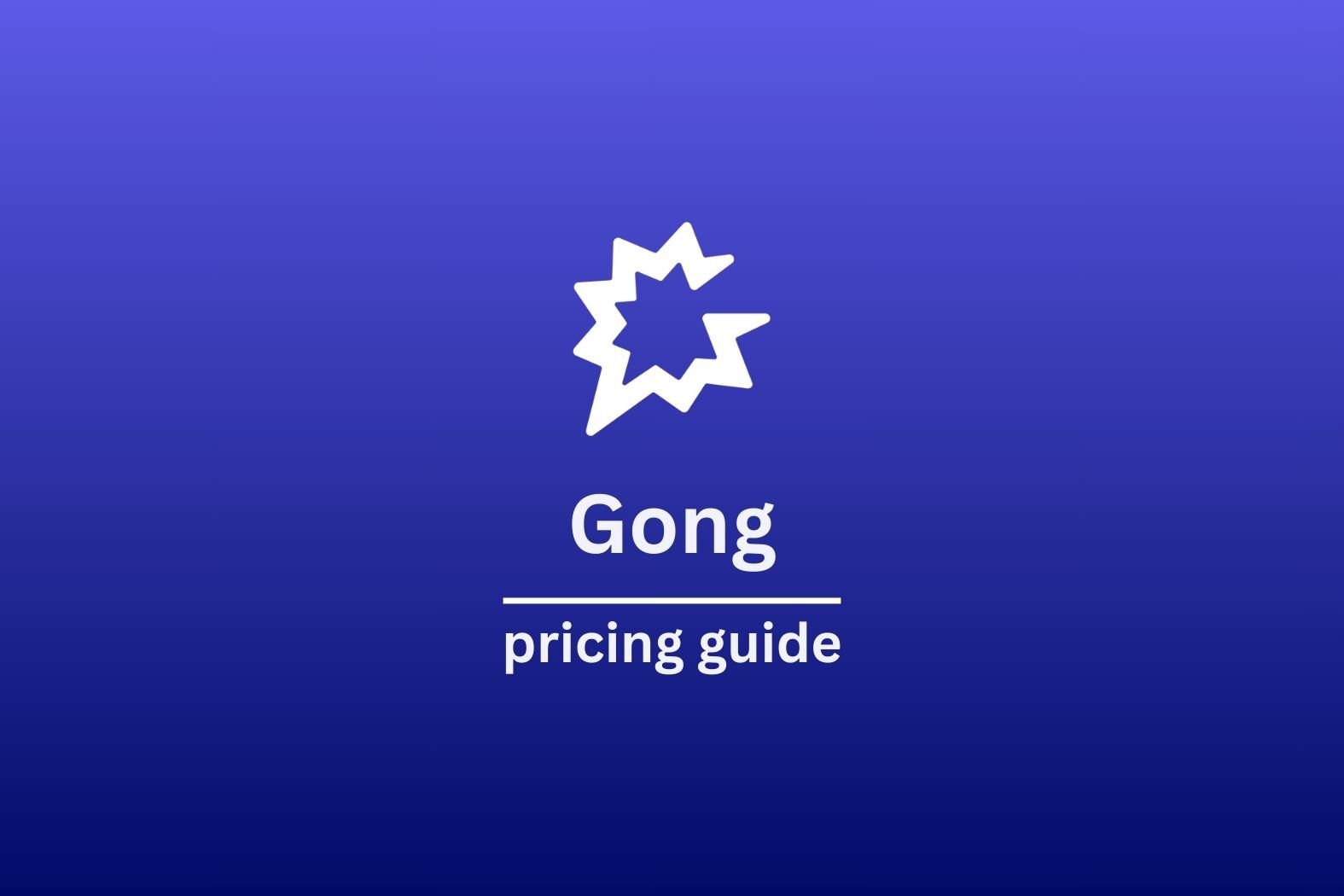Customer interviews are the gateway to the voice of the customer (VOC). Yet, for such valuable business insights, the execution of customer interviews is often rogue territory, with practices varying greatly from company to company, team to team. At tl;dv I have converged my customer success experience, including in roles such as Head of Customer Success, Head of Customer Experience and Director of Customer Success. From these experiences I have seen first-hand the impacts a robust customer success interview strategy has on the performance of not only the customer-facing teams, but also the bottom-up effects that transfer into other departments.
I’ll be taking you through my tried and tested customer interview questions, that dig beyond surface level customer preferences, to get to core customer motivations. I’ll also be showing you some of my secret customer success hacks.
We listen to our users and customers here at tl;dv. We don’t want any incidents like the following….
@tldv.io Don’t worry it was insured. #userresearch #tech #startup #ceo #uxdesign #uxresearch
♬ original sound - tldv.io - AI Meeting Recorder
Different types of customer interviews
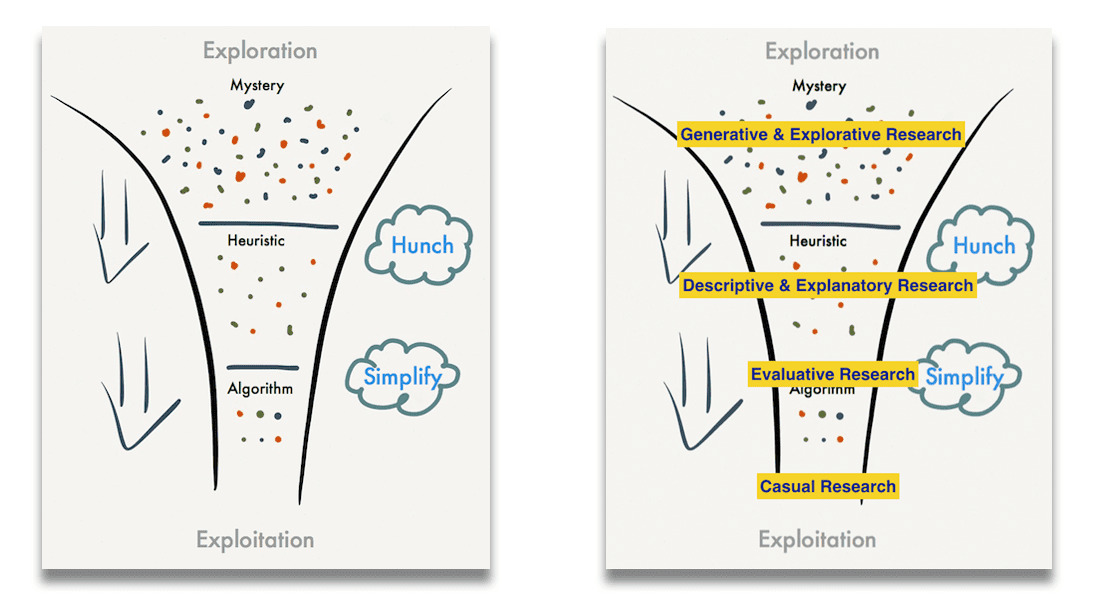
When I conduct my customer interviews, I like to borrow some principles from UX and Product design user interviews.
One of my favorite frameworks that can sometimes guide a customer interview and the customer interview questions that I choose is Roger L. Martin’s “knowledge funnel” which is often embedded in user interviews.
This knowledge funnel basically details the different stages that “knowledge” goes from “hunch” to validated hypotheses. Customer interviews can be conducted during earlier stages to collect information in order to draw hunches which to further investigate and validate with subsequent tests and customer interviews.
Customer Interviews to explore
Exploratory interviews are used to learn about a customer’s thoughts and emotions outside of the product context. It is a method of comprehending the individuals, systems, and goods with which customers engage to complete their task(s). You should pay particular attention not to direct the customer to your brand as the cure, but rather to discover the challenges, how they cope with them, and whether their need requires a standalone product or solution. This interview type is best used in earlier stages of the knowledge funnel, in order to form hunches and areas for further research and customer interviews. The goal here can be quite open-ended such as discovering new business opportunities, finding pathways to increase customer retention, or improving customer service.
Customer Interviews for validation
You’ll develop a hypothesis about how you can support your customers with their issues once you understand their problems. Validation interviews help us zero in on a specific customer issue.
This type of customer interview fits on the middle to end of the “knowledge funnel”. You have an idea and a hunch. You have tested this idea further with user and customer interviews. Now, the company has developed an MVP or product feature that addresses the concern of the customer (hypothesis). This customer interview is designed to test that hypothesis in order to scale further or revaluate.
Customer Interviews for efficiency
Efficiency interviews aim to identify inefficiencies in user flows. For each product function your company offers, you must observe how your customers use it. This will help identify any repetitive or misleading moves that you can fix with a product update. Customers may churn if your product is too confusing or complicated. If you want to cover all user flows with these interviews, emphasize the high-value channels and thoroughly test them.
This customer interview type is designed to develop insights that will positively impact customer retention and customer engagement.
Examples of customer interview questions
The best interview questions are those that don’t prime, but rather probe. By this, I mean it is important to get to the heart of every inquiry.
Don’t make assumptions as to why a customer gave you a response or preference. Ask!
However, when trying to get to the bottom of a customer’s perception, preference or motivation, don’t lead them towards a specific conclusion. Without further ado, here are some of my favourite customer interview questions:
Customer interview questions for identifying an issue or market gap
- What could be changed to make [process/role] a better experience for you?
- What is the most challenging aspect of being a [demographic]?
- What are some of your unmet needs?
- What is the most challenging aspect of your day?
- What commodity do you wish was available but isn’t?
- What activities consume the most time during your day?
Customer interview questions for product discovery
- What is the most challenging aspect of [the project you’re working on]?
- What are you doing right now to solve this problem/acquire this value?
- How do you know you’ve had a successful year/month/day? What do you like about [competitive product or service], and what do you hate about it?
- What would it appear like if you can somehow wave a wand and have any possible solution to this problem?
Customer interview questions for product discovery
- What is the most challenging aspect of [the project you’re working on]?
- What are you doing right now to solve this problem/acquire this value?
- How do you know you’ve had a successful year/month/day?
- What do you like about [competitive product or service], and what do you hate about it?
- What would it appear like if you can somehow wave a wand and have any possible solution to this problem?
Customer interview questions for product improvement
- What do you wish you could do that you can’t do today?
- What can be done to make this product better?
- What is the most challenging aspect of using this product?
- What makes you want to keep using this product?
- What about this commodity appeals to you the most?
- What is it about this commodity that makes you want to tell your buddies about it?
Customer Interview GPT Prompts
While the selection above gives a broad and insightful insight into customer preferences and needs, GPT can help uncover more detailed responses and feelings internally before you even get to the customer interview section. By utilizing GPT-driven tools, such as ChatGPT, you can brainstorm some new angles and insights to drive customer interviews forward.
Some ideas for prompts to get you started include:
- What are some potential assumptions about our customers and their needs?
- What information do we already have about our customers?
- What are the key challenges or pain points our customers in our industry are facing?
- How can we use customer insights to improve our product or service?
- How do our customers interact with our product or service?
- What are the key motivators for our customers to use our product or service?
- What are the key objections or barriers preventing customers from using our product or service?
- How can we better understand our customers’ behaviors and preferences?
- How can we use customer insights to differentiate ourselves from our competitors?
My personal tips and hacks to ace customer interviews
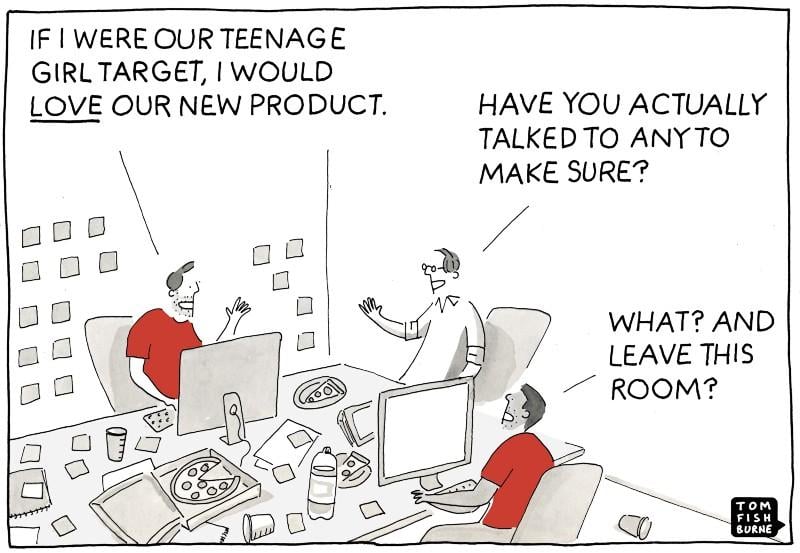
Everyone will have their own method of conducting customer interviews. That is fine. However, it is important that all customer interviews start with a plan and a goal.
Aside from the basics, such as being prepared, recording your customer interviews using a tool such as tl;dv, and being personable, here are some of my secret hacks to nail customer interviews and select the best customer interview questions.
Firstly, we must always keep these in mind:
- Developing a relationship with customers (to establish trust, so they open up).
- Efficient listening (to truly take in what they’re saying) is a skill that can be learned.
- Recording your sessions.
- Have a game plan.
- Share your interviews.
- Shut up and listen.
- Don’t ask leading questions.
- Get to know your customers beforehand
- Asking “detailed questions” to get a better understanding of what they’re thinking and feeling.
Do you like me?
There’s no need to elaborate here.
We all know that building rapport is the single-handed most important thing to do when conducting a customer interview.
As obvious as it is, it cannot be discounted from this list due to its supreme impact on the job.
Ways to do this in customer interviews include:
mirroring, asking for the correct pronunciation of their name, jokes, guiding the interview (people don’t like surprises, let them know what to expect), and be respectful of their time.
Basically, all the traits and behaviors required to be a good human being should be carried over to your customer interviews.
Here are some other common-sense do’s and don’ts from SneakerHead VC.
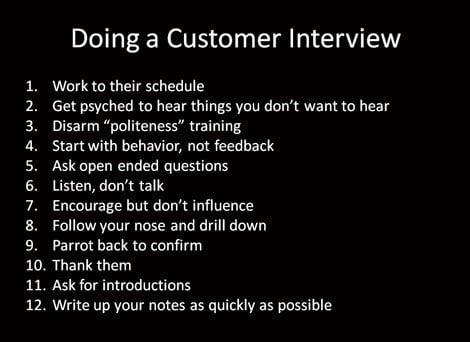
Have a game plan
The goals you set should be clear and should determine the type of customer interview you hold. Be clear with the interviewee about the goals of the session. For example, is the session about obtaining insights into the customer’s use of a product, or do you want to know detailed information about a customer’s pain points? Communicate this ahead of time and during the customer interview.
Not all goals need to be communicated with the customer. For example; will you be sharing your insights in your bi-weekly product-customer success syncs? Are you looking for more feedback on a particular product feature before launching next Spring? These are important questions to ask yourself before the interview, and should probably stay internal.
Don't rely upon your memory
Interview notes and transcripts must be compiled and condensed into a collection of distinct customer desires after the interview. However for a much easier way you can can record customer interviews. It’s faster, more efficient, hard to forget.
I personally use tl;dv to record all of our customer interviews. This could be recording on Zoom or recording on Google Meet, both are compatible with the tool. Being able to bookmark, share, save and, of course, record our customer interviews on the meeting platforms they’re familiar and comfortable with, has been a game-changer for me. Let me quickly talk about the “bookmarks” again. These are essentially timestamped bookmarks that enable me and my teammates to quickly navigate through any recording (long or short) to get right to the relevant portion. This is a real time-saver!
With the development of AI and GPT-driven tools, there is also now the chance to use “smart” insights. With tl;dv you can search by keyword in your online repository and tl;dv will compile a reel of mentions of that keyword. Along with automatic speaker recognition, transcription (in 20+ languages), and more, tl;dv is the ultimate AI meeting assistant for customer interviews and user research.
Shut up and listen
If you’re talking more than your customers, that’s a problem. Sometimes it can be tempting to cut in, either with follow up questions, correcting them about something related to the product or trying to help out trying to finish their sentences. You get a lot more insights if you don’t do it. So don’t cut in!
Don’t ask leading questions
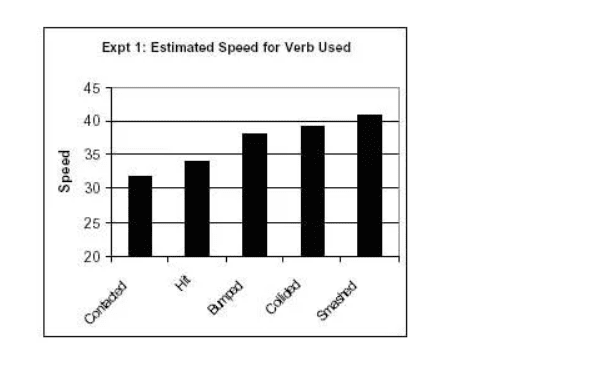
A group of people watched a film of a “car crash” and were asked to estimate the speed at which the vehicle was traveling when the cars “crashed”. The respondent’s answers varied by 9 m/h (14.5 km/h). The only variable which was changed, which elicited such different speed estimates from the participants was the verb used to describe the crash. As we can see from the graph above, words that conjure up feelings of a more severe collision influenced participants’ estimation of speed. This experiment was the Loftus and Palmer (1974) Study on the ability of language to influence eyewitness testimony and their memories. This test illustrates how people’s answers can easily be influenced by the way they’re framed, asked, or primed. There are numerous studies and experiments that back up language’s power over perception and behavior. Thus, it really is important to make sure you’re not asking leading questions that validate a hypothesis you want validated. Rather, keep your questions neutral.
Get to know your customer beforehand
Learn about their background. Find a common interest or even a common pet peeve. This is a great ice breaker to build rapport. I’m a true believer that a customer is a buddy. You’re trying to learn about their experience to improve your product but most importantly to make their lives easier.
Share your interviews
Sharing is caring. Here at tl;dv, we always record our customer interviews with tl;dv and then easily share them inter-departmentally.
Marketing, the founding team, product, everyone gets access to the insights! This is one way our customer interview’s value has been dialed up a notch. Through widening the net of insights and perceptions derived from customer interviews, we not only widen the actionable insights and potential direction for further research but also other departments are enriched with the insight from these customer interviews.
How does this translate in the real world?
I often share my customer interviews with the wider team. Product managers love listening to our customers directly as this influences their product and UX decisions and rationale. Marketing loves to listen to the insights, as this impacts their understanding of the customer and how to reach them best. There are numerous disciplines within one company that can benefit from seeing and hearing a customer interview, versus skimming through the interview notes.
Final thoughts on customer interview questions
The data you gather from your next customer interview may help you turn your product into the best possible MVP. Through effective customer interview questions, you will know which target markets matter and which don’t, as well as what customers would pay for and what might miss the mark. A good customer interview is invaluable to any company when prepared and strategized properly.


